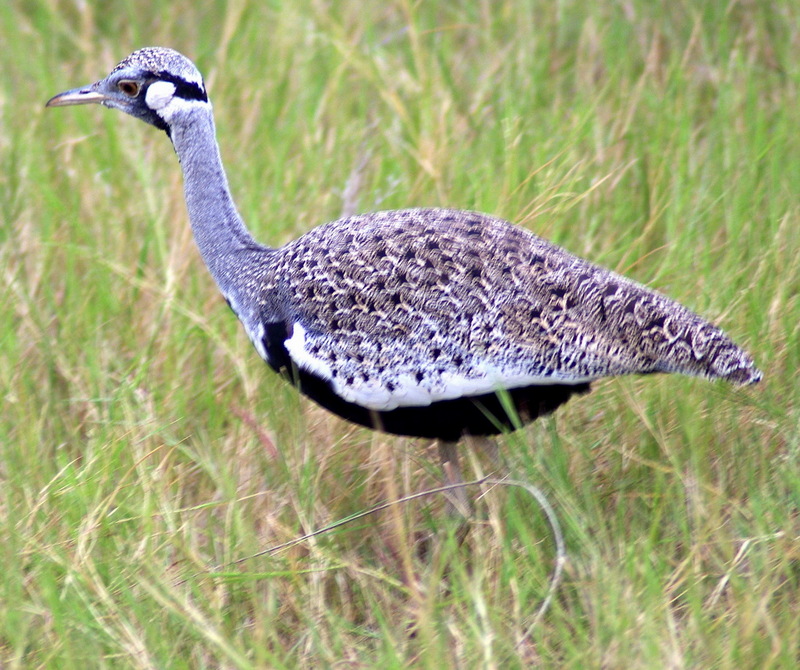|
| Query: otididae | Result: 34th of 37 | |
Black-bellied Bustard (Lissotis melanogaster) - Wiki
| Subject: | Black-bellied Bustard (Lissotis melanogaster) - Wiki
| |

| Resolution: 1226x1027
File Size: 506705 Bytes
Date: 2007:06:21 22:47:28
Camera: PENTAX K10D (PENTAX Corporation )
Exposure: 1/180 sec
Upload Date: 2007:11:22 16:46:40
|
ERROR : Server Busy(-1105)
ERROR : Server Busy(-1105)
Black-bellied Bustard (Lissotis melanogaster) - Wiki
Black-bellied Bustard
From Wikipedia, the free encyclopedia
Order: Gruiformes
Family: Otididae
[Photo] Male Black-bellied Bustard, Lissotis melanogaster (or Eupodotis melanogaster), in Kenya. Sharpened a little. Date June 22, 2007. Author Jerry Friedman (http://commons.wikimedia.org/wiki/User:JerryFriedman). Copyright (C) 2007 Jerry Friedman
Permission is granted to copy, distribute and/or modify this document under the terms of the GNU Free Documentation License, Version 1.2 or any later version published by the Free Software Foundation; with no Invariant Sections, no Front-Cover Texts, and no Back-Cover Texts. A copy of the license is included in the section entitled "GNU Free Documentation License". |
The Black-bellied Bustard (Lissotis melanogaster) is an African ground-dwelling bird in the bustard family. Some authorities (such as BirdLife International 2004) place it in the genus Eupodotis.
Description
The Black-bellied Bustard is 23 to 25 inches (58 to 65 cm) long. The bill and legs are dull yellow. The male's upperparts have black and brown marks on a tawny buff background; the underparts are black. The head is boldly patterned with black, white, and buff. The neck, long and thin for a bustard, is buffy brown with a thin black line down the front that joins the black breast. The tail is brown and buff with four or five narrow dark brown bands. The upper surface of the wings is white with a brown triangle at the base; the flight feathers have black tips except for the outer secondaries. The white of the wings is visible when the bird stands, contrasting with the black underparts (Zimmerman, Turner, and Pearson 1999).
The female is plain buff cryptically marked with darker brown mottling on the back and vermiculation (narrow wavy bands) on the neck and breast. The juvenile is duller and darker, with a dark grey crown and buff spots on the wing. The neck and rump patterns of both sexes, the male's white chin and lores, and the female's vermiculations are points that distinguish this species from its close relative, Hartlaub's Bustard (Zimmerman, Turner, and Pearson 1999).
Range and habitat
It is found in woodland and tall open grassland in sub-Saharan Africa (BirdLife International 2004). It prefers higher rainfall than Hartlaub's Bustard and in many areas occurs only following heavy rain (Zimmerman, Turner, and Pearson 1999).
Behavior
In feeding habits it resembles other bustards. In courtship display the male retracts his head to his back, giving "a short rising wheezy whistle, zhweeeeee", pauses in that position, and slowly raises his head, giving "a popping quock or plop followed by soft gurgling" (Zimmerman, Turner, and Pearson 1999).
http://en.wikipedia.org/wiki/Black-bellied_Bustard
| The text in this page is based on the copyrighted Wikipedia article shown in above URL. It is used under the GNU Free Documentation License. You may redistribute it, verbatim or modified, providing that you comply with the terms of the GFDL. |
|
Comments |
|---|
| | Guest |
|
| The picture is a male Hartlaub's Bustard, Lissotis hartlaubi. |
^o^
Animal Pictures Archive for smart phones
^o^
|
|
|

